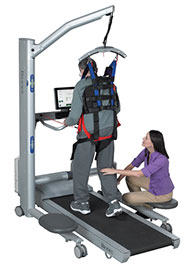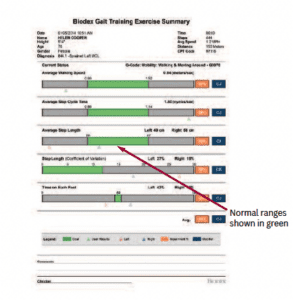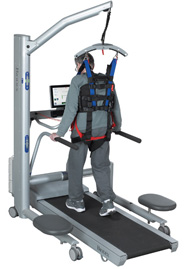A versatile product, providing capabilities for objective measurements of specific gait parameters as well as physiological measures of kinesthetic, proprioceptive abilities and neuromuscular control.

The Reactive Step Trainer (RST), has been designed to assist you in proven and controllable balance reeducation. RST delivers pre-selected perturbation challenges to help patients improve their compensatory step strategies. The Reactive Step Trainer allows you to set patients up for random perturbation challenges over a set period of continuous therapy for up to 20 minutes at a time. RST also gives you the control to challenge patients “on-demand” for close observation.
Our new Reactive Step Trainer combines all of the functionality of our Gait Trainer but now allows you to customize speed and perturbation intensity to help your patients improve their balance and reduce their risk of falling. RST must always be used in conjunction with a patient unweighing system for support and safety.
Click to Download Specification Sheet
Intended Use
The Biodex Reactive Step Trainer is both a gait assessment and fall recovery training tool. It is a versatile product, providing capabilities for objective measurements of specific gait parameters as well as physiological measures of kinesthetic, proprioceptive abilities and neuromuscular control. It is intended to be used as a training tool to assist patients with Gait Velocity, Average Step Cycle Time, Average Step Length, Co-efficient of Variation, and Time on Each Foot.
The Biodex Reactive Step Trainer includes the option to utilize Music-Assisted TherapyTM – an effective evidence-based tool for physical therapists and neurologists to enhance treatment of movement disorders and drive faster outcomes.* Reactive Step Training (RST), described in detail below, uses different types of perturbations – Slip, Trip, Step, Walk and e-Trip – to improve step recovery and dynamic balance and thereby reduce the incidence of falling.
Learn About The Biodex Gait Training System
Allow every patient the opportunity to get an early start on rehabilitation. Combine the Gait Trainer and NxStep Unweighing System for body weight-supported treadmill training (BWSTT) with unobstructed view and access to the patient.

Five types of perturbations – Trunk Stability Slip & Trip, Step & Walk Stability, and e-Trip – to improve step recovery and dynamic balance and thereby reduce the incidence of falling.
Instrumented Deck– The Reactive Step Trainer™ is the only treadmill with an instrumented deck that monitors and records step length, step speed and right-to-left time distribution (step symmetry).
Objective Documentation– Ideal for insurance reimbursement. Exercise Summary and Progress Reports display progress and document outcomes for specific gait parameters, including: –Average walking speed over time –Total exercise time –Total distance and steps taken –Average step length: RT vs. LT –Step length variability: RT vs. LT –Time on each foot: RT vs. LT
NEW Automated G-code Calculations and Impairment Level Reports– Increases efficiency and productivity, improves documentation of rehab effectiveness fostering continuity of care, helps with audits, efficiencies and reduces claims denial.
Normative Data– Age- and gender-based for comparison to healthy populations for assessment of patient results.
Audio and Visual Biofeedback– Motivates patients with real-time biofeedback, prompting proper gait patterns. Biofeedback help patients stay “on target” in each phase of rehabilitation; steps lengthen, step speed increases andsymmetry improves.
Heart Rate Monitoring– Polar®contact handgrips (telemetry compatible) ensures proper training intensity.

Large Display– Features 12.1″ color touch-screen display, powered by a Windows CE operating system.
Multipurpose Connectivity– Allows connection to larger monitors and LCD projectors to enhance interaction for visually impaired patients.
USB Compatibility– Accommodates external keyboard, a mouse, printing devices for remote operation and USB memory devices for data transfer and software upgrades.
Goal: Develop symmetrical gait by improving step length, step speed and right to left time distribution.
Method:
Have the patient walk at a comfortable step speed concentrating on symmetry of step length and step time. Once the patient has developed symmetry and cardiovascular gains, begin to work towards normative gait parameters. As an option, support the patient in the Biodex Unweighing System to provide a no-fall environment.
Results and Benefits:
When combined with the Unweighing System:
Allows concentration on treatment, not physically supporting the patient.
Reference:
American Geriatrics Society, British Geriatrics Society and American Academy of Orthopedic Surgeons Panel on Falls Prevention, Guideline for the Prevention of Falls in Older Persons, April 5, 2001.
Cress ME, Buchner DM, Questad KA, Essel PC, daLateur BJ, Schwartz RS. Continuous-scale physical functional performance in healthy older adults: a validation study. Arch Phys Med Rehabil 1996; 77:1234-50
Simpson JM, Harrington R, Marsh N., Guidelines for Managing Falls Among Elderly People. Physiotherapy, 84:4;173-177 April 1998.
Wolfson L. Whipple R, Amerman P, Tobin JN. Gait Assessment in the Elderly: A Gait Abnormality Rating Scale and its Relation to Falls. J of Gerontology 1990; 45:M12-19

Method:
Utilize audio cues and biofeedback to develop step length symmetry and right to left time distribution. Initially support patient’s body weight using the Biodex Unweighing System. Set treadmill belt in reverse direction (retro-walking) to assist with gains in range of motion. Forward direction of belt works on symmetry of step length and step time.
Results and Benefits:
When combined with the Unweighing System:
Reference:
American Geriatrics Society, British Geriatrics Society and American Academy of Orthopedic Surgeons Panel on Falls Prevention, Guideline for the Prevention of Falls in Older Persons, April 5, 2001.
Cress ME, Buchner DM, Questad KA, Essel PC, daLateur BJ, Schwartz RS. Continuous-scale physical functional performance in healthy older adults: a validation study. Arch Phys Med Rehabil 1996; 77:1234-50
Method:
Progressively address step speed and right to left time distribution. Use a slow initial belt speed (.10 cycles/sec – .50 cycles/sec). Clinician may assist with paretic limb placement to initiate step length. Visual cues are used initially to reinforce step length. Once step symmetry is reached, gait speed can be addressed.
Results and Benefits:
When combined with the Unweighing System:
Reference:
Barbeau, et al., Walking After Spinal Cord Injury: Control and Recovery
Gardner et al., Partial Body Weight Support with Treadmill Locomotion
Visintin et al., A New Approach to Retrain Gait in Stroke Patients Through Body Weight Support and Treadmill Stimulation
Suzuki et al., Determinants and predictors of the maximum walking speed during computer assisted gait training in hemiparetic stroke patients.
Suzuki et al., Relationship between stride length and walking rate in gait training for hemiparetic stroke patients.
Method:
Initially, concentrate on developing step length symmetry. Once symmetry is achieved, increase speed of the treadmill for progression towards normative gait parameters specific to the age, gender and leg length of the patient.
Results and Benefits:
When combined with the Unweighing System:
Reference:
Barbeau et al., Walking After Spinal Cord Injury: Control and Recovery
Gardner et al., Partial Body Weight Support With Treadmill Locomotion….
Visintin et al., A New Approach to Retrain Gait In Stroke Patients Through Body Weight Support and Treadmill Stimulation
Suzuki et al., Determinants and predictors of the maximum walking speed during computer assisted gait training in hemi paretic stroke patients. Suzuki et al., Relationship between stride length and walking rate in gait training for hemi paretic stroke patients.
Method:
Using audio and visual cues, initially concentrate on developing step length symmetry with focus on right to left time distribution. Once symmetry is achieved, increase speed of the treadmill for progression towards normative gait parameters specific of the age, gender and leg length of the patient.
Results and Benefits:
Reference:
Peterson et al., Physiological responses during unweighted ambulation of three patients with below the knee amputation: A pilot study.
Method:
Utilize audio and visual cues to assist the retraining of the temporal and spatial deficits associated with Parkinsonian Gait. The patient focuses on the visual and audio cues, which help to regulate step length.
Results and Benefits:
When combined with the Unweighing System:
Reference:
Morris et al., Stride Length Regulation in Parkinson’s Disease
Click to Download Specification Sheet
*Music-Assisted Therapy is being included at launch as a limited time offer.
| 950-600 | Reactive Step Trainer™ Includes Standard Handrails |
| 950-600 | Reactive Step Trainer™ 50/60 Hz, 115 VAC* Includes Support Bar |
| 950-485 | NxStep Unweighing System™ Sold Separately |
Course Presented by
Dr. Kevin E. Wilk